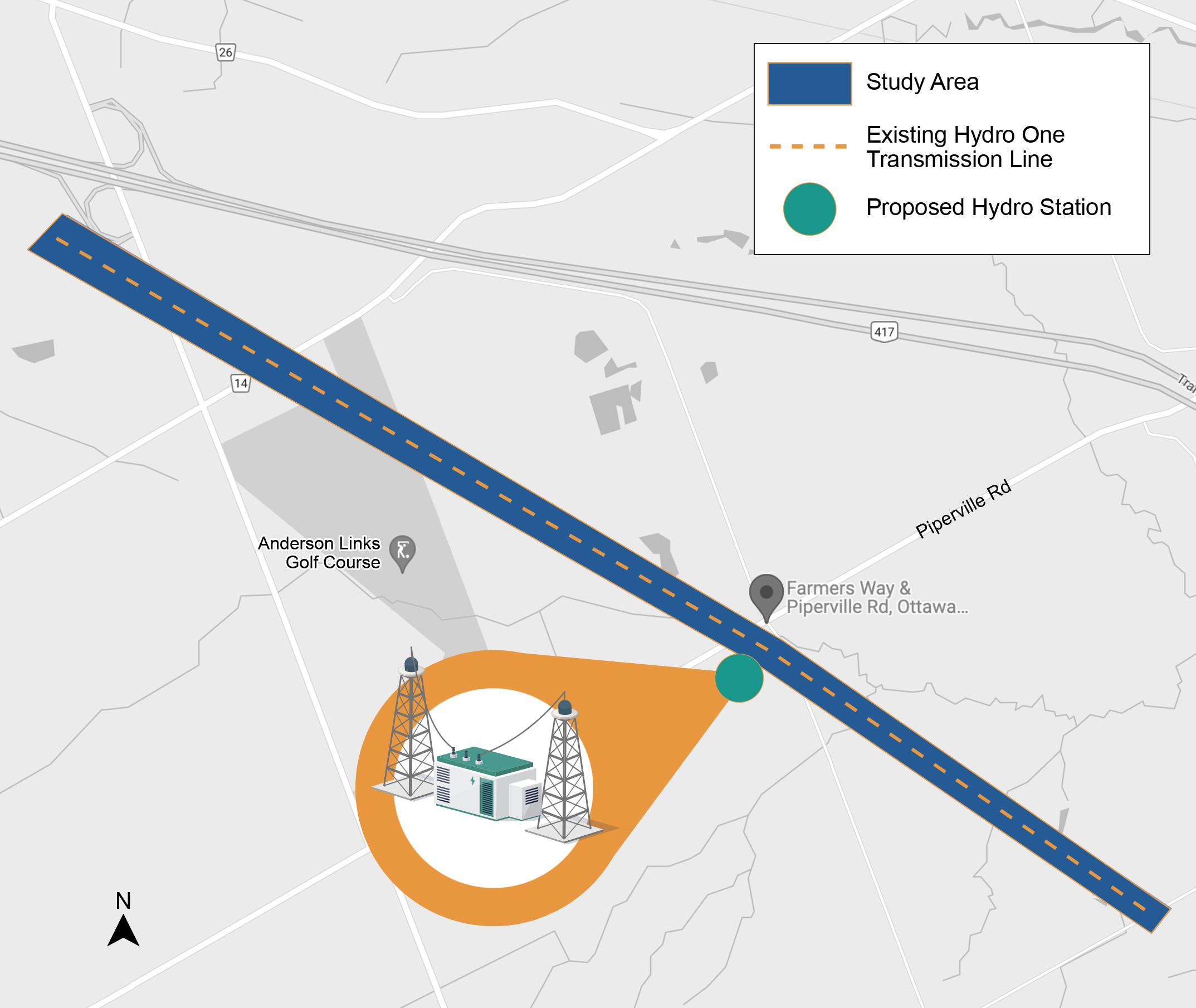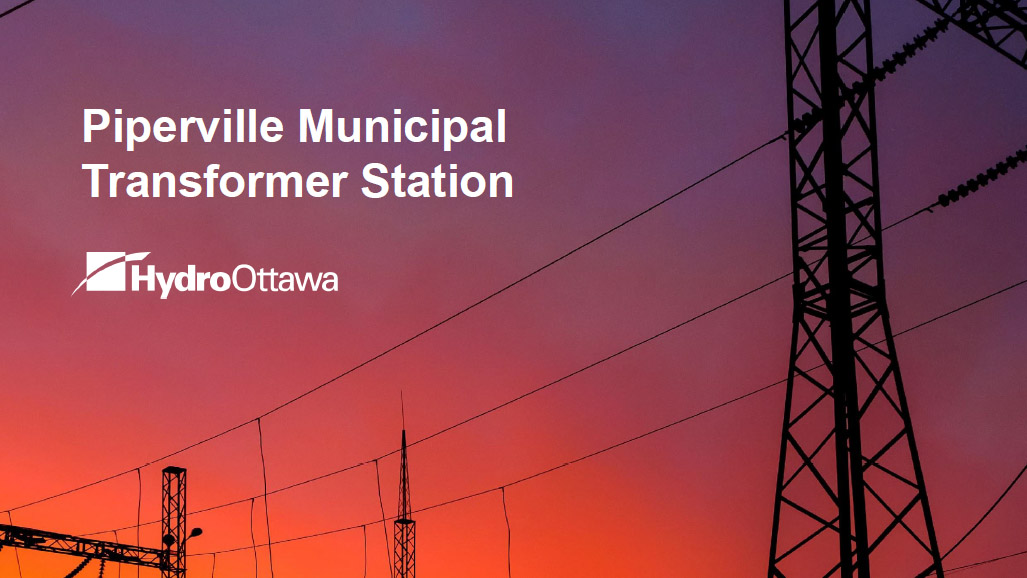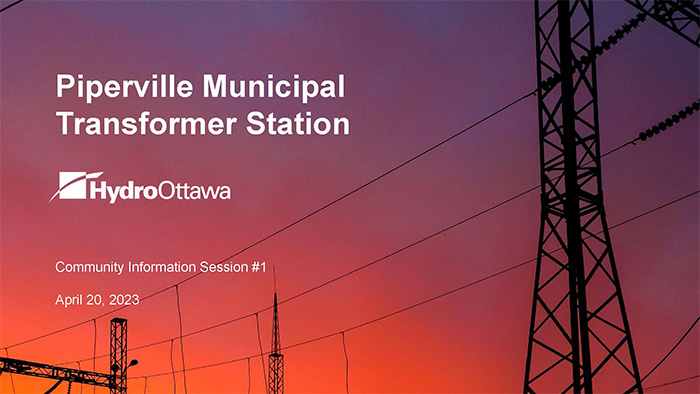March 2020 - September 2026
To ensure Ottawa’s eastern region has the power to grow, Hydro Ottawa has initiated a Class Environmental Assessment (Class EA) study for the construction of a new 27.6kV municipal transformer station in the southeast end of the city of Ottawa.
What will this project include?
The Piperville Municipal Transformer Station project proposes:
- to construct a new 27.6kV municipal transformer station (MTS) at the intersection of Piperville Road and Farmers Way (located on the west side of Highway 417); and
- to connect the new power station to Hydro One’s existing 230kV transmission line, also located on the west side of Highway 417.
As part of our sustainability commitments, Hydro Ottawa intends to develop Piperville as a low-carbon substation.
We are currently undertaking a full project review of the station’s construction, including an innovative design, procurement and construction techniques that include using lower Global Warming Potential (GWP) materials, and equipment that will address embodied carbon associated with the construction and operation of the substation.
Why we are moving forward with this project
The need for new facilities was identified through the Integrated Regional Resource Plan (IRRP) for the Ottawa area. Released in March 2020, the IRRP is a twenty-year plan that has been developed by a regional planning working group consisting of the Independent Electricity System Operator (IESO), Hydro Ottawa and Hydro One.
This project will support projected growth in electricity demand for the area and provide redundancy to our system in the event of future extreme weather events. The Piperville Municipal Transformer Station is one of many future-planning projects we are spearheading to make our electricity system as resilient, and as sustainable, as possible.
The existing Hydro Ottawa station in the area does not have the capacity to supply anticipated future demand in this part of the city.
Final Environmental Study Report
January 29th, 2024
This Final Environmental Study Report describes the technical and environmental studies undertaken on behalf of Hydro Ottawa Limited for this project.
Resources from Community Information Session 1
Contact
If you have questions about the project, or you would like to receive project updates, including information about upcoming community information sessions, join our mailing list. Email us at [email protected].
FAQs
A municipal transformer station (MTS) “steps down” the voltage of the electricity being delivered by a high-voltage transmission line to a lower voltage that is suitable for distribution to local customers. Distribution lines are generally on wood poles along the road allowance, and may also be underground in some areas.
A reliable source of electricity is essential to supporting community growth - powering homes, schools, businesses, hospitals and transportation. In March 2020, the need for a new station was identified in a twenty-year Integrated Regional Resource Plan.
The Piperville Municipal Transformer Station (MTS) project is being proposed to support projected growth in electricity demand in the southeast parts of the city of Ottawa in the coming years. The existing Hydro Ottawa station in the area does not have the capacity to supply anticipated future demand in the southeast growth area.
Contingent on the Class EA and other approvals, the new Piperville 27.6kV municipal transformer station (MTS) will be located on the west side of Highway 417 at the intersection of Piperville Road and Farmers Way, and connect to Hydro One’s existing 230kV transmission line.
The Integrated Regional Resource Plan is a twenty-year plan that has been developed by a regional planning working group consisting of the Independent Electricity System Operator, Hydro Ottawa and Hydro One.
Regional system planning ensures a reliable supply of electricity to regions across the province and considers a range of solutions including conservation, generation, transmission and distribution, as well as other resource options to ensure that electricity is available when needed.
We have selected a property parcel as small as possible for the needs of the project. While many trees on the property will need to be removed, we will only cut those which are strictly necessary.
Preliminary assessments indicate that the birch trees and undergrowth visible from the road will need to be taken out. Depending on the final setback of the station, this could also include approximately 50 meters of vegetation into the woodlot.
All vegetation removal will be thoughtfully considered, along with mitigation measures, in accordance with the recommendations of the Class Environmental Assessment and input from the local community.
Mitigation measures could include tree planting, vegetation buffers, decorative and community-friendly fencing, and/or an earth berm along the frontage of the site to visually mask the municipal transformer station and dampen operational noise and vibration.
Yes. As a utility, we plan decades ahead and consider Ottawa’s unique electricity needs, including strengthening our own distribution network and infrastructure. We also look at new opportunities and innovative technology like distributed energy resources that can help build redundancy.
From a climate and planning standpoint, Hydro Ottawa considers recent years and events that point towards a new reality requiring contingencies to better protect the electricity grid, our systems and our customers.
Further consideration is also given to meeting greenhouse gas reduction targets set by various levels of governments (plus our own 2030 zero-emission goal), as well as a future of mass electrification.
We are spearheading a lot of future planning to make the electricity system as clean, sustainable, and resilient as possible.
In 2021, Hydro Ottawa customers had power an average of 99.987 per cent of the time (99.981 per cent in 2020). Events like the May 2022 derecho can shake customers’ trust in the reliability of the system and stoke fears of lengthier power outages in the future. As such, Hydro Ottawa is building back stronger and investing in the grid and new technology to mitigate risks.
A Class Environmental Assessment (Class EA) takes a broad and all-encompassing view of the environment. Potential effects of the project will be examined through a number of detailed studies, taking into consideration factors relating to:
- the natural and socio-economic environments; cultural/heritage resources; recreational resources; existing and planned land uses; visual landscapes; technical/cost considerations; and the concerns and interests of local business and residential property owners, Indigenous communities, government agencies and other interested parties.
A number of natural environment field studies will be undertaken in the project area as part of the Class EA process. This will include:
- Species at Risk (SAR) surveys, as required by government agencies; Ecological Land Classification; botanical and tree surveys; aquatic habitat assessments; incidental wildlife observations; and, potential significant wildlife habitat mapping. Where effects on the natural environment cannot be avoided, appropriate mitigation measures will be proposed.
A project of this scale can take five to seven years from initial planning until completion. There are many steps involved including development work, the EA process and other approvals, and construction.
To provide sufficient electrical capacity to support growth in the southeast area of the City, the current plan is to have two transformers at the new station, similar to the size of our Cambrian municipal transformer station in south Nepean. Specific information about the design of the new station is not available at this time as this will be developed during the environmental assessment.
Many factors are taken into consideration when planning projects of this size, including feasibility, cost, reliability, and seeking to maximize the use of existing electricity infrastructure, where possible. These decisions are not taken lightly, and above all, are always made with our customers in mind.
A more detailed cost estimate will be developed by Hydro Ottawa as it moves through the project approval process and undertakes detailed engineering and designs for the facilities. The allocation of project costs will be determined as part of the Ontario Energy Board approval process.
Yes. As part of our sustainability commitments, Hydro Ottawa intends to develop Piperville as a low-carbon substation.
We are currently undertaking a full project review of the station’s construction, including an innovative design, procurement and construction techniques that include using lower Global Warming Potential (GWP) materials, and equipment that will address embodied carbon associated with the construction and operation of the substation.
Yes. This is currently being reviewed. Additional generation can connect either to the new station or directly to the connection line. It is possible for renewable generation and other innovative technologies, such as energy storage and distributed energy resources, to provide additional power in order to address the area’s need. We will share more information on this as it develops.
Hydro Ottawa is spearheading a lot of future planning initiatives to make our electricity system as clean, sustainable, and as resilient as possible. This includes major infrastructure projects like municipal transformer stations.
Ontario’s electricity sector is one of the cleanest in the world, producing nearly 94 per cent of electricity completely free of GHG emissions.
Electric and magnetic fields (EMFs) are invisible forces that surround all electrical appliances and equipment, power cords and wiring found in your home. This is the same for outdoor power lines and equipment operated by utility companies. These fields are at extremely low frequency. The field strength is strongest close to its source and fades rapidly as you move away from the source.
Hydro Ottawa defers to Health Canada on the issue of EMFs. Health Canada does not consider that any precautionary measures are needed regarding daily exposures to EMFs at extremely low frequencies.
There is no conclusive evidence of any harm caused by exposures at levels found in Canadian homes and schools, including those located just outside the boundaries of power line corridors.
Once the design for the new MTS is determined, Hydro Ottawa will be able to project how EMFs might change.
During the construction phase of the project, local residents may see various types and frequencies of construction traffic depending on the stage of the construction. That being said, there will not be a sustained long-term traffic impact associated with the Piperville project.
Once operational, traffic generated by the station will generally be limited to a monthly site visit by a technician since the station will be remotely monitored. During major weather events, required maintenance or other related system needs, the station may be visited more frequently depending on Hydro Ottawa’s need as part of our commitment to deliver safe, and reliable electricity to our customers.
Understanding that any construction activities can be very disruptive, we want to assure residents that all construction activities and any possible power interruptions will be scheduled and planned very carefully.
Further, to ensure the safety of the public and our crews as a result of the work required for this project, the majority of the work will be completed weekdays between 7:00 a.m. and 5:00 p.m., and in accordance with City of Ottawa noise by-law.
There are no power outages planned at this time. Plans are in place so that electricity service can be maintained during construction of the new facilities.
If there is a need for a planned power outage of more than four hours in duration, we provide our customers with as much notice as possible. This includes notifications by phone, text and/or email depending on the account contact information we have on file, as well as hand-delivered letters where applicable. We also post notices on the planned work section of our website.
The station is supporting local development in the area which may bring associated increases in property values.
Mitigation measures will be implemented in accordance with the recommendations of the Class EA, which will include input from the local community. There could include, for example, tree planting, vegetation buffers, decorative / community friendly fencing and/or an earth berm along the frontage of the site to visually mask the MTS, and to dampen operational noise and vibration.
A reliable and safe supply of electricity can be a positive attribute for the area, and for property values.
When the need was first identified for the station, three locations were selected as possibilities due to their close proximity to the existing transmission corridor and the available connection points for the 230kV line.
As such, Hydro Ottawa pursued interest in all three locations, but the lot near the intersection of Piperville Road and Farmers Way was the only property available for purchase.




